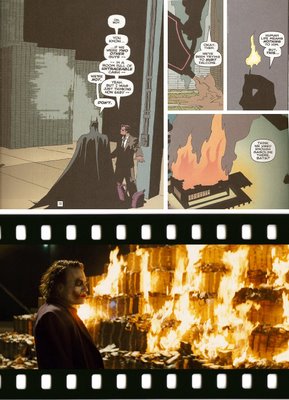While the comics of Frank Miller, Graham Nolan (Knightfall) Alan Moore (The Killing Joke) are very notable, these seminal works from Jeph Loeb and Tim Sale are equally influential of the Batman embraced by Christopher Nolan and a major force behind The Dark Knight. Darker in tone while maintaining the comical tone of the villains, Sale and Loeb mix the dark noir and crime tone of Miller and Moore with the colourful camp tones of the series and golden age comics.
Haunted Knight (1996) is a special collection from the authours, three halloween tales that is, like a Simpsons Halloween special, a retelling of three stories that was the first pairing of the two. “Fears”, the first tale, is a cat and mouse game between Batman and Dr. Jonathan Crane/Scarecrow, “Madness” is a game between Mad Hatter and Batman inspired by Lewis Carrol’s Alice in Wonderland, while “Ghosts”, the finale, has Batman traveling through the past, present and future with members of his rogues gallery a la Dickens’ A Christmas Carol.
DC kept the pair together and in 1998 Loeb and Sale began to produce The Long Halloween. Continuing with the theme of Halloween, this time we follow a serial killer who kills on holidays, starting with a bombing at the house of Harvey and Gilda Dent on Halloween. Many frames and scenes in the first issue are later reference in The Dark Knight. The Long Halloween focuses as much on Batman’s rogues gallery as it does the family of Carmine Falcone, the mob rivalry of his family and Salvatore Maroni and the relationship between Batman, Harvey Dent and is as much a crime saga as it is a fantastical story with hyperbolic villains. We can easily see, with such a taut balance of tones, characters and a carefully weaved narrative how it was such an influence on The Dark Knight.
The Long Halloween also carefully reconfigures one of the most intangible and inconsequential villains of the rogues gallery into something with a little bit more depth: Calendar Man. Often a joke of the rogues, his quirk is that he kills based on trends he finds in dates on a calendar. Thats it. But imprisoned he is left to his thoughts and is at times consulted when the police are tracking the killer they have now dubbed “Holiday.” Who is Holiday? I won’t spoil it here, because it’s a really great read, but he is a fitting villain aptly mixing the realistic and fantastic with a fitting conclusion.
In 99-2000, Loeb and Sale followed up The Long Halloween with Dark Victory. Directly carrying on with the themes and story, Dark Victory follows Batman’s continued hunt of organized crime families in Gotham as well as their ties to other cities. The Falconi’s relationship with the Vitti family in Chicago is of note. This importantly extends Gotham City closer to the real world and Loeb as a writer shows a considerable talent for subtly blending these worlds. It’s closer our very real world which would allow criminal “freaks” like Joker, Two-Face, Solomon Grundy and the like to exist.

Dark Victory also introduces Robin to this Batman storyline. It’s a retelling of Dick Grayson–the first of many Robins–and his family’s death at the hands of crime families. I’ve often said while reading Dark Victory that due to the intro to Robin and the presence of Two-Face it would have made a much better version of Batman Forever. Dick Grayson here is younger but filled with rage (something O’Donnell seemed to have a problem conveying) and is hellbent on revenge.It’s a much darker tone for the story, but establishes the kind of relationship without the homoerotic undertones that often plague the relationship in the past. Sale and Loeb reconfigure to make sure it’s understood that Batman and Robin is a father-son relationship. Bruce sees in young Grayson the same guided rage that drove him to become Batman so he uses his resources to train him in body and mind to be a tool for justice in Gotham. Through this relationship and process we can easily see how Grayson easily grew into the role of Nightwing and was able to both leave Batman–leaving room for the more troubling Jason Todd–and at times don the Batman cape and cowl.
The Long Halloween is such a clear guide for Christopher Nolan with The Dark Knight and Batman Begins that it’s almost a wonder if we would have much of the film without it. They really are a great compliment to Nolan’s films and thats more than can be said of any of the Burton/Schumacher films which draw from style and tone. Combining that with narrative is what clearly separates Nolan’s films from the former, and drawing from such interesting sources is why they’re now counted among the higher canon of Batman’s stories.
Bits and Bats
- The Long Halloween follows the story from Frank Miller’s Year One, the events picking up six months after Gordon’s altercations with Detective Flass. Flass and several other characters make appearances in The Long Halloween.
- Some key Dark Knight references: a large, organized pile of the mob’s money being burnt; someone disguised as a uniformed SWAT (Gordon in Dark Knight and Batman in Long Halloween).
Next Up: Knightfall


I haven’t checked out dark victory yet, but long halloween is one of my favorites of all time
Long Halloween is very good, but I was surprised how good Dark Victory was. I particularly though it would have made a great film, like a more grown up “Batman Forever.”
Right as nuts in a ballsack